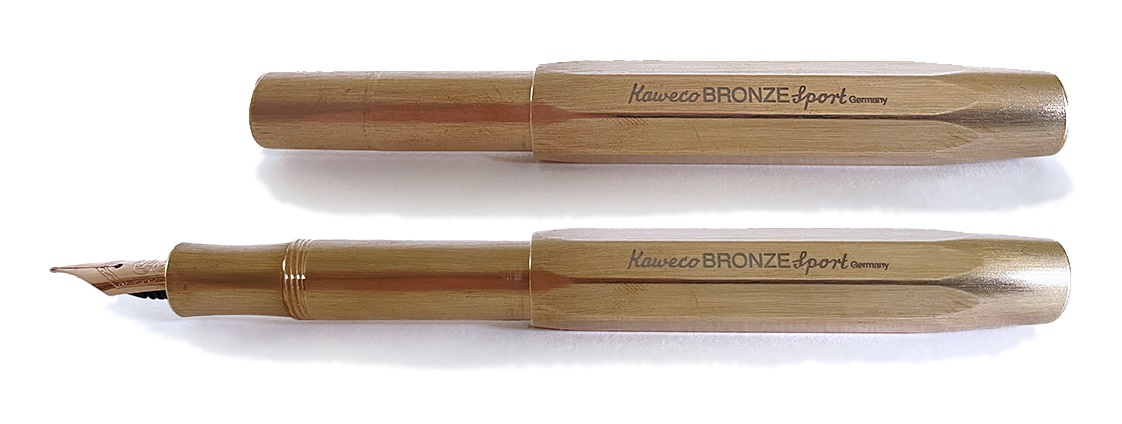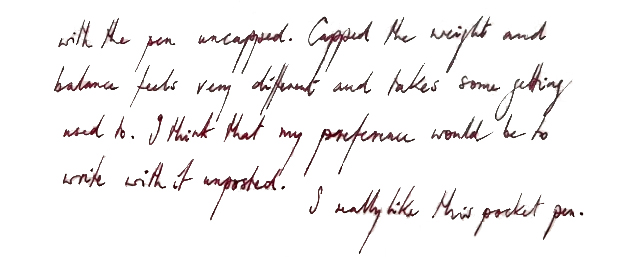A little bit of history Having started out as a hard rubber writing device, then become near ubiquitous in its modern plastic incarnation, the Sport has also diversified into a dizzying range of metals in recent years. The aluminium version is still fairly light, but the brass, steel, and silver (yes, it exists, but we can’t afford to review it) versions exude heavyweight confidence – literally. To that collection of cheeky chonksters we can now add one of the earliest metals worked for tools by humans; bronze. An alloy of readily available copper and slightly rarer tin which made Cornwall the most famous part of these islands in the, err, Bronze Age, bronze has a relatively low melting point but sets heavy and hard enough to make most tools from. It doesn’t hold an edge terribly well, so bronze swords were superseded quite quickly once the Iron Age came about, but as we all know the pen is mightier.
 How it looks Like a slightly rosier version of the brass Sport, in short. That doesn’t really do it justice, though. In the modern world there’s not so much bronze to be encountered in every day life so this looks special, unusual, and maybe even a bit other-worldly – or perhaps an object from another time. That Nuremberg Tardis has been busy! Opinion is divided on whether to polish or tarnish, and adherents of either camp regard their opposites as absolute barbarians, so perhaps it is best to observe simply that if you buy one, the choice is yours.
How it looks Like a slightly rosier version of the brass Sport, in short. That doesn’t really do it justice, though. In the modern world there’s not so much bronze to be encountered in every day life so this looks special, unusual, and maybe even a bit other-worldly – or perhaps an object from another time. That Nuremberg Tardis has been busy! Opinion is divided on whether to polish or tarnish, and adherents of either camp regard their opposites as absolute barbarians, so perhaps it is best to observe simply that if you buy one, the choice is yours.
How it feels Hefty, but warm. As long as you don’t mind a bit of extra weight, it’s more friendly in the hand than aluminium any day.
 How it fills As with all Sports, syringe-filling a cartridge is the most cost-effective way to get a usable quantity of ink in to the diminutive barrel. It’s not too tricky once you get used to it.
How it fills As with all Sports, syringe-filling a cartridge is the most cost-effective way to get a usable quantity of ink in to the diminutive barrel. It’s not too tricky once you get used to it.
Crucially, how it writes… Now that depends what nib you put it, of course. Like most ‘premium’ Sports it’s designed for Bock’s shorter #5 nib, the 060, and the steel versions of these fitted by Kaweco as standard usually work pretty well. With a bit of careful feed surgery, trimming the tops of a few fins, it will take the slightly longer 180, which allows for a rose-gold-plated steel nib, as worn by our test unit. We think it looks beautiful, and writes accordingly too.
 Pen! What is it good for? As originally intended, it’s a classic pocket pen and does that job mightily well too. But with a bit of work with Brasso, it will look the business on display on your desk too.
Pen! What is it good for? As originally intended, it’s a classic pocket pen and does that job mightily well too. But with a bit of work with Brasso, it will look the business on display on your desk too.
VFM At around £140 this is one of the pricier Sports, but if you like the alloy, you’ll love using this. It might be worth trying a more affordable Sport first in order to be sure that the fairly small nib and short barrel suits your grip, though.
 The only way is ethics Made in Germany, with minimal packaging, there are no major worries on this count.
The only way is ethics Made in Germany, with minimal packaging, there are no major worries on this count.
If this isn’t quite your cup of tea, but almost… The brass or steel Sports are the closest alternative. For other bronze pens… you might be hunting for quite a while!
 Our overall recommendation The Sport is a robust workhorse beloved of many of a fountain pen fan. If you like a weighty pen, and the look of bronze appeals, go for it.
Our overall recommendation The Sport is a robust workhorse beloved of many of a fountain pen fan. If you like a weighty pen, and the look of bronze appeals, go for it.
Where to get hold of one Thankfully this is not a limited edition, so most of the fountain pen specialists will be stocking it.
 This meta-review references:
This meta-review references:
- Scribble Monboddo’s red letter
- Dapprman’s patina of respectability
- Mick’s spit and polish
- Nick Stewart’s holy tarnation
Thanks to Kaweco for the review sample.